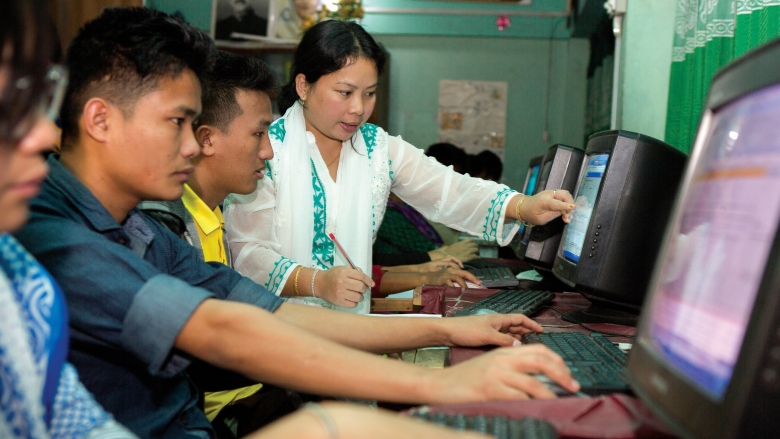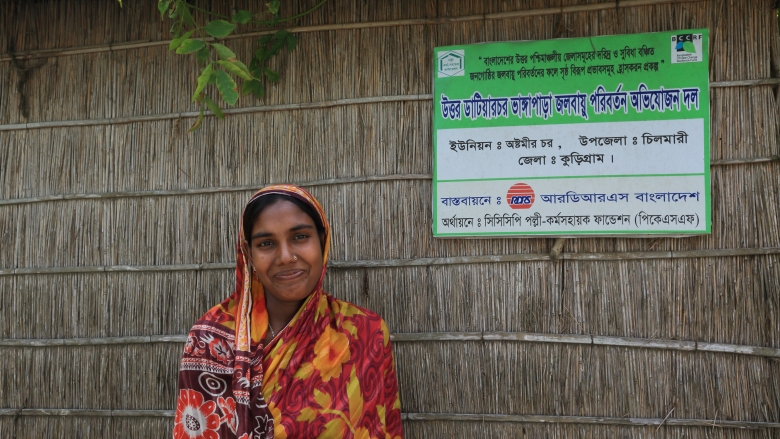Challenge
Bangladesh is both an inspiration and a challenge for policymakers and practitioners of development. While the income growth, human development and vulnerability reduction efforts to date have been extraordinary, Bangladesh faces daunting challenges with about 22 million people still living below the poverty line. The country is at an important juncture: with the right policies and timely action, it can move up within the middle-income bracket. The World Bank has identified job creation as the country’s top development priority. To do so, Bangladesh will need to remove the barriers to higher growth posed by low access to reliable and affordable power, poor transportation infrastructure, limited availability of serviced land, uncertain and complex business regulation, rapid urbanization and vulnerability to climate change and natural disasters, among others.
Approach
The World Bank has been a longstanding partner of Bangladesh since its independence. The World Bank through its concessional lending arm—the International Development Association (IDA)—has committed more than $28 billion in grants, interest-free and concessional financing credits to Bangladesh. The World Bank has also been the largest external funder of Bangladesh providing over a quarter of all foreign aid to the country. The World Bank has been supporting the government’s efforts in economic development and growth, power, infrastructure, disaster management, climate change, human and social development and poverty reduction.
The World Bank Group’s Country Partnership Framework (CPF) for 2016-2020 supports Bangladesh to achieve its vision of reaching middle-income status by its 50th birthday in 2021. During the period, the World Bank Group’s technical and financial assistance focuses on (i) accelerating growth by helping to remove structural bottlenecks and provide financing to increase electricity supply and improve transport connectivity; (ii) foster social inclusion by building on Bangladesh’s impressive gains in human and social development; and (iii) strengthen climate and environmental management with the aim to enhancing Bangladesh’s resilience to natural disasters, improving water and natural resource management and modernizing agriculture. The framework is anchored in the government’s seventh Five Year Plan which covers the same period.
Results
Decades of IDA financing has contributed to the achievement of results across a range of sectors as follows:
Education
- Net enrollment rate at the primary school level increased from 80 percent in 2000 to above 90 percent in 2015, and at secondary school level increased from from 45 percent in 2000 to around 62 percent in 2015.
IDA is the largest external funder in the education sector covering the primary, secondary, and tertiary levels, as well as technical training and vocational training, and education for the hard to reach children. , including 55 percent of poor girls supported by a range of stipend programs.
Health
- 40 percent reduction in maternal mortality, from 194 deaths per 100,000 live births in 2010 to 320 deaths in 2000.
- 2.3 children per woman in 2014, from around 3.3 children per woman during the 1990s.
- 13,006 functioning community clinics in 2014.
- 64 percent of pregnant women receiving Ante Natal Care (ANC) from a medically trained provider in 2014, up from 53 percent in 2007.
The World Bank is aligning its financing and technical support by supporting the government’s fourth Health Nutrition Population (HNP) sector program (2017-2022). The HNP program focuses on strengthening health system governance, management and service delivery capacities, and implemention of essential services package, with a focus on lagging regions — Sylhet and Chittagong Divisions.
Rural Infrastructure
- 800 km of new roads paved, 4,500 km rural roads in 26 districts maintained and 47 km of rural waterways dredged.
- Road safety engineering measures implemented and community road safety awareness-building campaign ongoing.
- 1.1 million people with access to clean water in rural areas.
IDA support for rural roads have helped people access schools and health facilities with reduced transport costs and less commute time; increased rural non-farm incomes; and created jobs for both women and men. Financing for piped and non-piped resources has improved people’s access to clean water, especially in areas with high arsenic and salinity infiltration.
Energy
- Addition of 2,147 MW electricity to the national grid, and 100 MW to off grid through solar home systems with IDA support in the last decade.
- More than 4 million households and shops in remote areas – such as the remote island of Sandwip — have installed solar home systems with support from IDA and other development partners.
- Expansion in pilot solar irrigation pumps, solar mini grids and other renewable energy options and ione million improved cookstoves installed.
The World Bank is providing $1.66 billion to ongoing activities in the energy sector to enhance capacity, generate clean energy, improve transmission and system operation, reduce technical losses, as well as increase access to both grid and renewable electricity.
Agriculture
- Over 1 million rural households modernizing farm practices and using new technologies with IDA support.
- 500,000 households receiving through IDA financed project to increase grain reserve to meet their post-disaster needs, and improvements in the efficiency of grain storage management.
While the country has aving one of the fastest rates of agriculture productivity growth in the world since 1995 (2.7 percent per year, second only to China), this self-sufficiency is continuously threatened by a decrease of arable land by at least one percent per year, an increasing population and stagnating yields.
Climate Change
- 240 new cyclone shelters constructed; 387 km of embankment repaired; 501 solar irrigation pumps installed; 17,500 hectares of block plantations and 2,000 km of strip plantations completed in climate vulnerable areas.
- 40,000 people residing in saline, flood and drought prone areas have received adaptive basic needs (house, water, agriculture, health) and livelihood support.
- About 6,000 poor and forest dependent households in 200 communities participated in the alternative livelihoods support programs.
The World Bank, with IDA resources is helping Bangladesh build stronger disaster-coping mechanisms – such as schools that double as cyclone shelters – and these have significantly reduced the impact of recent storms, cyclones, and floods in terms of numbers of deaths and economic losses. The 2014 Climate Change Vulnerability Index ranks Bangladesh as the number one economy at risk to climate change. Bangladesh has been a frontrunner in adaptation and disaster preparedness.
Local Governance
- Since 2006, IDA has been supporting a nationwide program that augments the government’s block grants to the all the Union Parishads (the lowest tier of elected local government, there are 4,504). The block grant enables Union Parishads to decide and spend on local priorities.
- Since 2006, 130 million people benefited from the discretionary funds that a Union Parishad receives annually, which has grown by more than ten-fold.
- 30 percent of the funds are managed by female members are managing 30 percent of the funds.
- More than 35,000 community schemes generating employment for poor people have been implemented, including construction or rehabilitation of rural roads, culverts, drainage and embankment systems; water and sanitation facilities; and schools and clinics.
Local government institutions in Bangladesh traditionally had a limited role in delivering services to their citizens due to limited responsibilities coupled with lack of adequate resources. Under the ongoing third project financed by IDA, block grants are being institutionalized twith the government’s own resources and urban fiscal transfer system is being piloted in 16 municipalities.

